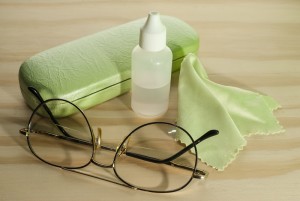I enjoy the convenience of being able to research and order glasses online. When it comes to prescription eyeglasses or even just “readers” (as some like to call them), there are a few areas of concern that may apply to you or a loved one.
Companies like discountglasses.com offer great prices and cute frame styles. Most of your questions can probably be answered by reading their FAQ’s. They are helpful in explaining the basics. Like how to enter your prescription and getting your PD measurement from your Optometrist.
However, there are some vital measurements that certain prescriptions and lens designs require for the clearest vision. You just can’t accomplish these measurements without actually putting on the frame.
#1. Single-vision Lenses
The optical center if often called the sweet spot or the part of the lens with the clearest vision. Your PD or pupillary distance measurement determines the horizontal placement of the optical center. If the vertical measurement is not specified the lab will use a default setting which is determined by taking half of the frames total vertical measurement.
 For example: Look in the mirror with your glasses on and notice if your eyes are in the exact center of the frame. Most people will find that their eyes are looking through the upper part of the frame not the center. Children are especially prone to this since their nose or bridge is much flatter than adults resulting in the frame sitting lower in relation to their eyes. Also note that popular plastic frames have no nose pads which will make it sit lower on your bridge.
For example: Look in the mirror with your glasses on and notice if your eyes are in the exact center of the frame. Most people will find that their eyes are looking through the upper part of the frame not the center. Children are especially prone to this since their nose or bridge is much flatter than adults resulting in the frame sitting lower in relation to their eyes. Also note that popular plastic frames have no nose pads which will make it sit lower on your bridge.
This means that most people will benefit by having this vertical measurement taken. Also, if you have a prescription that includes astigmatism and/or you are quite near-sighted or far-sighted your vision will be affected by not having the optical centers directly in front of your eyes.
To acquire the measurement you need to put on the frame you selected. Have someone place a dot on each lens, directly over your pupils. Then measure from the lowest part of the frame up to the dot…this measurement is given to the lab so they can accurately place your lenses into your frame.
#2. Bi-focal and Tri-focal Lenses
 The bi-focal lens design looks like a half-moon in the lower part of the lens. A bifocal lens has two powers. The top part of the lens can contain your distance or arms length or computer power and the half-moon area of the lens will contain your near or reading power.
The bi-focal lens design looks like a half-moon in the lower part of the lens. A bifocal lens has two powers. The top part of the lens can contain your distance or arms length or computer power and the half-moon area of the lens will contain your near or reading power.
A tri-focal lens has three powers and looks like a bi-focal lens with an extra area above the half-moon shape. That area contains your arm’s length/computer power. This will allow you to have a distance, computer and reading power all in one lens. I personally prefer a Progressive Lens, which we’ll talk about later.
Multi-focal lenses are best fitted by someone familiar with the correct placement of where the line should cross through your vision. If it’s too high then the line or lines will bother you when viewing distances. If it’s too low you’ll have to lean your head back to use the reading area. A real pain in the neck!
To achieve an accurate measurement, you need to be wearing the frame you want to use and have a skilled person determine the correct height. Online eyeglass companies use a default measurement of 3 mm below the optical center of the lens. Sometimes it’s too high and sometimes it’s too low. It all depends on where your eyes look through the frame.
#3. Progressive Lenses
Progressive lens designs require very accurate measurements, and the more advanced designs require additional parameters that are very unique. Digital surfacing and customized fields in the newer lenses can only be obtained at an Optical Shop and fit by a trained staff or Optician.
Standard or old-style progressives are offered online, but I can’t recommend ordering them because of all the possible problems you may encounter. I have experienced disappointment in many people who have been improperly fit with progressive lenses. A person’s lifestyle, vision prescription and their frame selection all determine the best lens design choices.
#4. Lens Materials
Safety, thickness, weight, optics and durability are some of the many properties of a lens that need to be considered when making your choices. Polycarbonate is a commonly used material because it is impact resistant and light weight, but it scratches easier and doesn’t offer the sharpest vision possible. Trivex, standard cr-39/plastic or high-index may be better options for you. Then there is good old glass, sometimes it’s the only solution.
